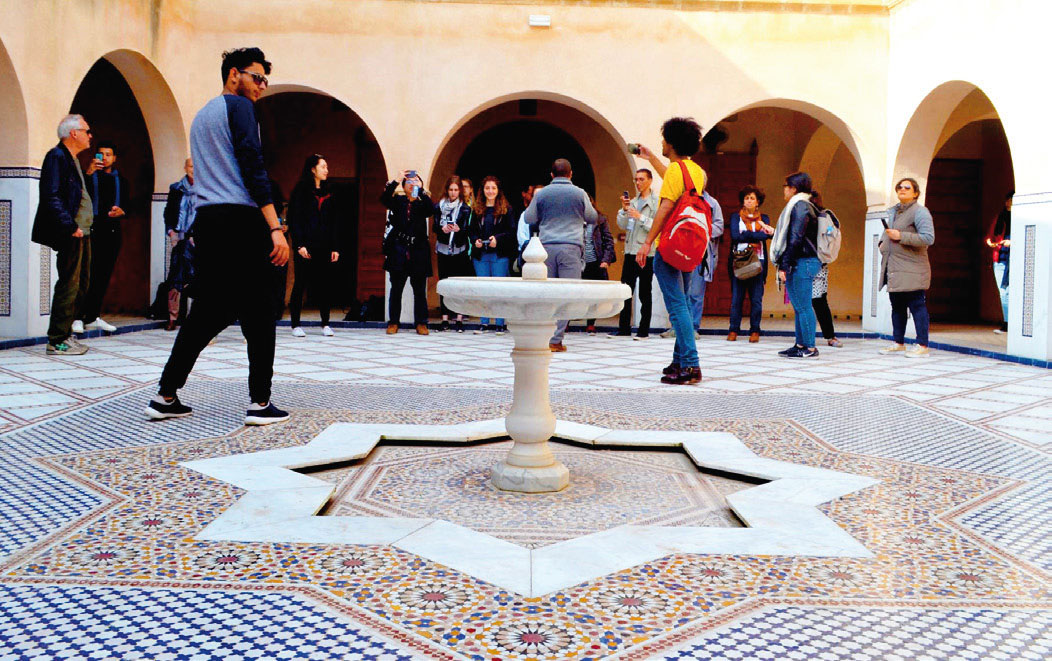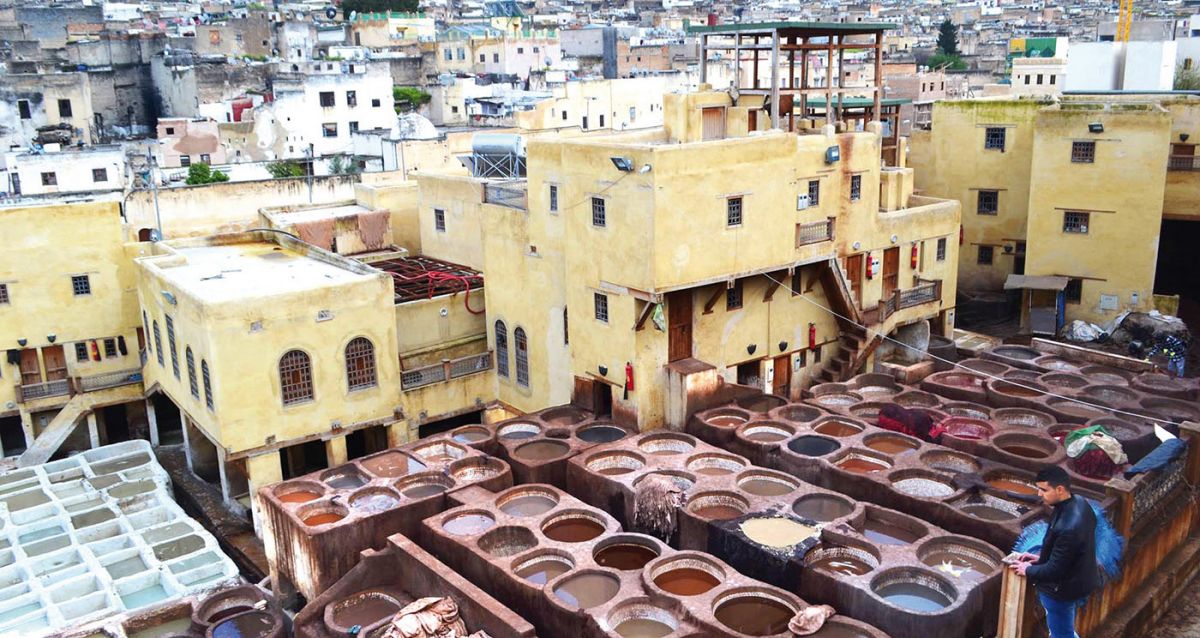A sense of heritage. Student discussion in Morocco
<p>Fieldtrip Critical Heritage Studies<br>Morocco, 4-8 April 2018</p><p>In April 2018, students and academics from Leiden University in the Netherlands and Mohammed V University in Morocco embarked on a five-day journey to be immersed in the complexities and history of the expression of cultural heritage in Morocco. The trip was organised by the International Institute for Asian Studies (IIAS) and the Netherlands Institute of Morocco (NIMAR) in Rabat, Morocco.</p>
Eleven students from the IIAS-coordinated Critical Heritage Studies programme at Leiden University and twelve Museology students from Mohammed V University shared a learning experience about the complexities of heritage in Morocco. The study trip was led by an entourage of five academic experts with different disciplinary backgrounds, including Philippe Peycam (Director of IIAS), Léon Buskens (NIMAR), Willem Vogelsang (Deputy Director of IIAS), Elena Paskaleva (lecturer and coordinator of the Critical Heritage Studies programme at Leiden University) and Paul van der Velde (ICAS Secretary), who all actively participated in the academically stimulating and culturally enriching exchange. It was a five-day immersion in Moroccan architecture, museums, and, most importantly, food that brought us in touch with the multi-faceted aspects of the cultural heritage of a country that is trying to find its own voice.
Day 1: Tardy trepidation
Schiphol Airport, eight o’clock in the morning. What began as an uneventful trip turned into momentary worries upon touchdown in Casablanca where two of the members of our party were held in limbo by customs, pending approval of their visas for entry into the country. The rest searched frantically for Wi-Fi and dirhams, some with more success than others. After customs released the required visas, we were off to Rabat where we, running late, finally met with the students from Mohammed V University and their professor Mohammed Saïd El Mortaji. The two groups introduced themselves over a cup of mint tea and Moroccan sweets.
After tea, the Leiden group was steered to stunning panoramic riverside views set against the late evening sun. What followed was a tour through Rabat’s historically and culturally significant sites, guided by professor Mohammed. By the time dusk had fallen, Oumaima Oualid, a PhD candidate in Critical Heritage at Mohammed V University, led us through the bustling streets and plazas of Rabat. We took time to admire the tiled fountains of the souk [market place]. Originally serving as gathering places for the locals and their animals to water themselves as well as to catch up on the latest gossip, these fountains are now being renovated with the added purpose of heritage-making and attracting tourists. The group then dined in an Italian restaurant where we had the chance to learn about, discuss and exchange views on topics ranging from Muslim prayer beads to political divides in Morocco. After dinner, although very enthused, most of us were longing to find our beds.
Day 2: No sh*t talk about my city
Morning breakfast at café Lina with French pastries, coffee and a jus d’orange. A visit to the heart of Casablanca, guided by shamelessly proud architect and Casablanca native Labib El Moumni who would not accept, in his words, “sh*t” talk about his city. He guided us through the wide boulevards lined with colonial-era Art Deco architecture, remnants of the French protectorate. The city design, culminating in the symbolic clock tower, punctuated Casablanca’s firm feet in the future. El Moumni highlighted the architectural details that showed the change in emphasis from French to a Moroccan identity.
Our tour ended with our first traditional Moroccan lunch, during which Léon Buskens proposed we consider assumptions about authenticity by illustrating the fluidity of changes in cultural heritage with the history of our drinking glasses on the table. They were originally an exercise in frugality, made from recycled glass, and used primarily in restaurants. The concept of bildy, or ‘authentically made’, turned these previously low-cost, mass-produced glasses sold for 1 dirham a piece, into twenty-five euro glasses sold in Parisian shops!
From there, it was a dash to the train back to Rabat for Leon’s lecture on ‘The Past and Future of Morocco’, providing our group with the context from which to consider the coming sites on our visit. Afterwards, the group split up, and a small satellite group went to have dinner in a local restaurant to have a first taste of the local cuisine.
Day 3: 3D lectures
A morning trip to the city of Salé by tram, where the main maritime gate of Salé and archaeologist Dr Mohamed Krombi awaited us. With infectious enthusiasm, Dr Krombi gave the group an extended tour during which he halted at important archaeological sites. Animated and with great passion, he captivated his audience’s attention as he told the tale of the history of Salé, once the political and maritime centre of Morocco. He led us to the top of the maritime gate, gifting us with a beautiful view. Although Salé houses more citizens than Rabat, it has lagged behind in political and economic resources. Rabat and Salé have a centuries-old feud that still lives on today. The new tram system, even if it facilitates commuting, has so far failed to foster any warm feelings between the two cities. After admiring a renovated caravan sarai [roadside inn], we enjoyed a cup of mint tea with a snack called msemmen – a pancake-like bread that is eaten throughout the day.
Back at the NIMAR institute, three Leiden students presented their research; we then visited the Musée de l’Histoire et des Civilisation, an archaeological museum that aims to bring Moroccan heritage and history to life, starting from prehistoric times to the Islamic era. After wrapping up our visit to the museum, the group arrived at the buildings of Mohammed V University where the Leiden students continued their presentations for the day. The Moroccan students were invited and encouraged to consider how the topics presented could be implemented in a Moroccan context. The souk of Rabat was a welcome respite at the conclusion of the tours and presentations, where the students now had a chance to spend some time together. Our gracious hosts were happy to show us the souk and all its surprises. Students bought herbs and spices, sweets and boxes, all while experiencing the smells and sounds of a vibrant, lively souk, a living entity, defined at its core by the people and their relationship with it. The bargaining and the stories told while being immersed in the atmosphere brought home the idea that ‘heritage’ is not at rest, but alive, and dynamic.
Day 4: Lost in the souk
The city of Fes. Guided by al-Mountasir Loukili, we visited Dar Batha Médina, the new museum of Islamic art, constructed by the French using parts of houses of the Moroccan nobility of Fes. Rooftop drinks at a café near one of the old city gates revealed how the city works to protect old buildings, using removable architectural components and allowing public use while protecting the building at the same time. We resumed our tour to visit the Al-Attarine Madrasa, built during the height of decorative Islamic architecture. Continuing to navigate to our next destination, however, revealed the logistical challenges of manoeuvring a group of thirty through the souk, past carts, people and enticing shops, inevitably resulting in the group splitting up and some getting lost. The remainder of the group continued to enjoy the tanneries, amongst other sites.
There was something about this souk that left a deep impression on most of us. From the market stalls came a barrage of sounds and sights; this place had its own pace and life. Some students had the opportunity to shop and bargain at the local stores. From the Moroccan students and the merchants of the souk, the Leiden visitors learned about locally produced goods, their uses, who uses them and why, which provided insight into Moroccan daily life and culture. When the group was reunited again, we shared our last traditional Moroccan dinner with the other students and teachers, exchanging memories, impressions, and inshallah, aux revoirs and not-adieus.
Day 5: There and back again
We were sorry to have to leave Morocco, a beautiful country we had just begun to explore. Our bus was ready to take us back to Casablanca Airport, but as trips go, things do not always happen according to plan. It was by coincidence, and our misfortune, that our bus was held up for 45 minutes by a marathon in the city centre. Consequently, many of us did not make the flight back to Amsterdam and had to spend the night in Casablanca before continuing the journey home on the following day. One flight and a ride on the Thalys brought everyone home safely, thus ending our journey.
Reflections
It is very well possible to learn about and engage with critical heritage studies in the Netherlands, but the privilege of traveling to a country so vastly different from one’s own afforded us the invaluable experience of ‘understanding’ away from our textbooks and outside the comfortable realm of the classroom. It made us keenly aware of the importance of context and the relevance of learning from people who are in close contact with the culture under investigation. The senses also played an important role in the experience. Sounds, smells, tastes and textures add depth and colour like spices add flavour to food, something that a PowerPoint presentation in the classroom cannot convey. Heritage, understood as something fluid, evolves through exchanges, continuously re-invented, and as societies change, their heritages change with them.
Heidi Jie and Eun Chae Park, students from the Double Degree in Critical Heritage Studies of Asia and Europe programme, and participants of the Morocco fieldtrip.

